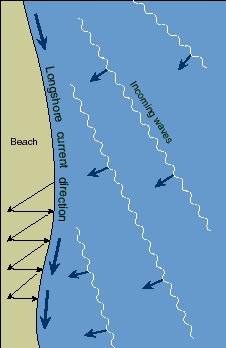Longshore currents affect shorelines by
transporting local sediment(s) from one point to another in the
beach system.
Geologists call this movement littoral
drift.
Longshore currents are formed due to the seasonal waves are
continuous. For longshore currents to establish themselves, the
waves must come into shore at an angle. The interaction of the wave
energy and the sediments are encountered, when a wave enters
shallow water it is said to be feeling the bottom. This drag placed
on the wave energy causes breakers (what most people call a wave).
As one wave meets the shore and breaks, another wave is right
behind it, preventing the broken wave from flowing backward. This
causes a slight build-up of water volume at the shore. The back and
forth movement of the waves coming in and out, combined with the
angle of the wave allows the individual grains of sediment to be
moved up and down the beach face.

Materials:
Beachball
Watch
Measuring tape
What you will need to do to log this cache:
1. Measure off and draw a 30 foot line in the sand parallel to the
ocean;
2. Position one person at each end of the line you have drawn.
Position everyone else along the line. One person should assume the
role of timekeeper and have a watch with a second hand;
3. Throw a beach ball into the water, just behind the line of
breakers, approximately 6 feet behind the beginning position;
4. When the beach ball passes the beginning of the line the
timekeeper should start timing.
5. When the beach ball passes the person stationed at the end of
the line, tell the timekeeper to stop timing. Record time on
notepads;
6. If time permits, repeat this process up to a total of three
times;
7. Using the formulas given (Speed = Distance/Time), calculate the
speed of the longshore current, and then calculate the average of
the longshore current today
.
TODAY'S DATE: ___/___/___TIME OF DAY: _______TIDAL STAGE:
____________
WEATHER CONDITIONS:
_______________________________________________
WIND DIRECTION:
_____________________________________________________
_____________________________________________________________________
OBSERVATIONS:
______________________________________________________
_____________________________________________________________________
Send an email to the cache owner of what your trial speeds were.
If this is not doen within 24 hours of logging the cache, the log
will be deleted.